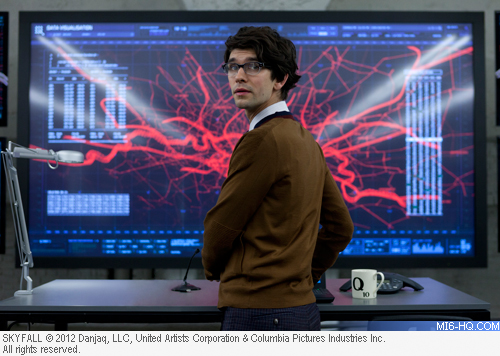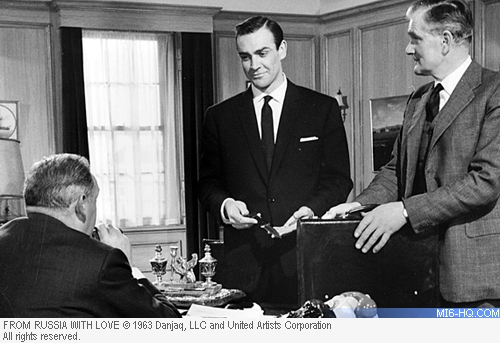 |
| |
As Ben Whishaw revives Fleming's famed Quartermaster, guest writer Edward Biddulph looks back at the literary roots of the character...
|
|
Q: From Page To Screen
21st November 2012
When Ben Whishaw's Q hands a ticket to Shanghai, documents and a passport to James Bond in "Skyfall", he is - in a way - returning to his literary roots. The character, reintroduced to the Bond series after a two-film absence, has been given a contemporary make-over. No longer the irascible inventor, the Q of "Skyfall" is a techno-geek, a computer whizzkid with all the resources of Q Branch at his fingertips. But in supplying documents, as well a gun and a radio, Q might have been taken from the pages of Ian Fleming.
There is, of course, no character named Q in the original Bond novels, but there is a Q Branch, and Bond makes use of its services frequently. In "Casino Royale" (chapter 3), M tells Bond to talk to Q [branch] about arranging trains, hotel rooms and equipment. In "Live and Let Die" (chapter 18), Q Branch supplies Bond with a frogman's suit, while in "Diamonds are Forever" (chapter 5), Q Branch provides a US visa, a vaccination certificate, and an attaché case that hides a silencer and 30 rounds of ammunition. Bond receives another, more sophisticated, attaché case in "From Russia, With Love" (chapter 13). This 'bag of tricks' built by Q Branch's technicians conceals 50 rounds of ammunition, two flat throwing knives, a cyanide pill in the handle, 50 gold sovereigns, and a silencer hidden in a tube of Palmolive shaving cream. And while on desk-duty ("Goldfinger", chapter 5), Bond phones Q Branch to arrange the dispatch of a crate of limpet mines destined for Hong Kong.

Above: Ben Whishaw as techo-boffin, Q, in "Skyfall".
|
Other gadgets and equipment are described in these and subsequent novels, notably Bond's Aston Martin DBIII, fitted with a homer, reinforced steel bumpers, switches to alter the lights, and a long-barrelled Colt .45 in a secret compartment, but there is no reference to Q Branch and we cannot be sure that the department is responsible for them. There are, in addition, names and institutions which seem to complement, or even duplicate, the work of Q Branch.
The Identicast machine that Bond uses to build up a picture of Goldfinger is operated by the Records department of the secret service ("Goldfinger", chapter 7). Captain Troop is Head of Admin during the events of "From Russia, With Love" (chapter 11), and presumably oversees supplies of materials destined for the field, and in "Dr No" (chapter 2), Bond is introduced to his trusty Walther PPK by the Armourer, Major Boothroyd. In "On Her Majesty's Secret Service" (chapter 8), Bond turns to Passport Control for a false passport in the name of Sir Hilary Bray, which presents something of a terminological conundrum. In the real world of MI6, a passport control officer is the euphemistic description of an intelligence officer attached to a diplomatic mission abroad, and indeed Fleming correctly identifies MI6's Commander Strangways as 'Passport Control Officer' for Jamaica ("Dr No", chapter 3). But in using the term 'Passport Control' in "On Her Majesty's Secret Service", Fleming was surely referring to a Q Branch-like department within the secret service, as British passports were officially issued at the time by the British Passport Service.
Like many of his ideas, Fleming's concept of a dedicated department tasked with equipping agents for the field has some basis in reality. Some of the equipment that Fleming described was inspired by contemporary Cold-War spycraft. Fleming, as ever, followed advances in technology and took great interest in developments, such as miniature radio transmitters and bugging devices.
Above: First edition cover art for three key Fleming adventures in which 007 is aided by Q Branch. |
Fleming may also have drawn on his wartime experience. The Second World War was a fruitful time for boffins, technological wizards, and innovative thinkers who were encouraged to develop ingenious gadgets, such as compasses hidden in buttons, maps placed in hairbrushes, and flexible saws concealed in bootlaces, to help agents or military personnel behind enemy lines. Much of this work was carried out by MI9, the branch of the secret service dedicated to escape and evasion, and the Special Operations Executive (SOE), whose remit was to organise, aid and direct resistance movements in enemy-occupied territory. One of the technicians responsible for many of the gadgets, Charles Fraser-Smith, would become famous after the publication of his memoirs in 1983 as the apparent inspiration for Fleming's Q Branch. However, the much broader role of Q Branch in the novels, the absence of a Fraser-Smith-like character, and the paucity of the sort of gadgets typically associated with Fraser-Smith (the attaché case of "Goldfinger" is one of the few pieces of equipment that resembles those wartime gadgets), raise questions about how much Fraser-Smith inspired Fleming. In any case, there is no doubt that Fraser-Smith's celebrity owed more to his identification with the post-Fleming film character of Q than it did to an association with Ian Fleming.
While there is no Q character in the Bond novels, the Q of the films evidently grew out of Ian Fleming's writing. In the first Bond film, "Dr No" (1962), we are not introduced to Q, but the armourer, Major Boothroyd, played by Peter Burton, in a reasonably straight adaptation of the passage in the original novel in which Bond exchanges his Beretta for a Walther PPK. Desmond Llewellyn took over Burton's role in the next film, "From Russia With Love" (1963), and though his scene is not found in the original book, the structure of the scene copies the armourer sequence of "Dr No", allowing Llewelyn, still called Major Boothroyd but now described as the equipment officer, to explain the workings of the attaché case to Bond. Llewellyn returns in the third film, "Goldfinger" (1964), and for the first time is identified as Q. Despite the expanded interplay between Bond and Q, and Q's relocation to his laboratory, in essence the scene fulfils the same explanatory function as those earlier sequences.

Above: Desmond Llewelyn is introduced as the Quartermaster in the 1963 adventure, "From Russia With Love".
|
"Goldfinger" famously marked a significant change in the approach to the role of Q, with the director Guy Hamilton insisting that Llewelyn's portrayal should reflect Q's hatred of Bond's cavalier attitude to the gadgets. The result was a character that not only demonstrated the gadgets to Bond, but was also irritated by Bond as he did so. This approach was ostensibly retained throughout Desmond Llewelyn's tenure, although as the film series continued, Q was less a backroom boffin and more a science and technology expert. In addition, the affection and respect between Q and Bond increased, with Q becoming a father-figure or mentor to Bond. Llewelyn's Q latterly served as comic relief, and appeared to have fun, occasionally at the expense of his own beloved gadgets, notably in "Licence to Kill" (1989).
John Cleese's Q in "Die Another Day" references the humour and interplay of his predecessor in the earlier films. In his first film, "The World Is Not Enough", Cleese, then Q's assistant, was presented as a slightly clumsy white-coated lab technician, albeit a character just as irritated by Bond. There was no Q in "Casino Royale" or "Quantum of Solace", although the forensics technician in "Quantum of Solace", played by Brendan O'Hea, was the sort of role that might have been accommodated by Desmond Llewelyn's Q in earlier films.
The character of Q is an invention of the cinema, but would not have existed without Ian Fleming's novels. The first film, "Dr No", took the armourer of the original novel. The second film conflated the character with the technicians of Q Branch described in the novel of "From Russia, With Love". In the third film, Q was fully realised. By this time, the character had branched-off from Fleming's novels and began to evolve along its own trajectory. Ben Whishaw's Q represents the latest stage of that evolution, but by issuing travel documents, a radio and gun, returns something of Fleming's original Q Branch to the screen.
About the Author
Edward Biddulph is the author of "Licence to Cook: Recipes Inspired by Ian Fleming's James Bond", and writes 'James Bond memes' (http://jamesbondmemes.blogspot.co.uk/), a blog exploring the ideas and influences behind James Bond.